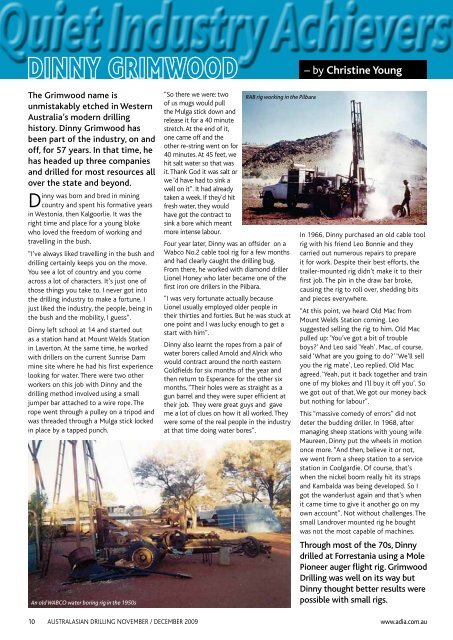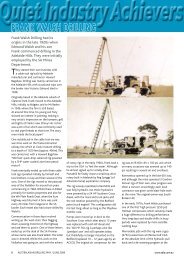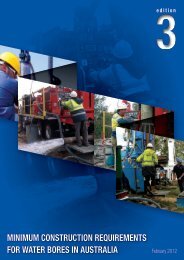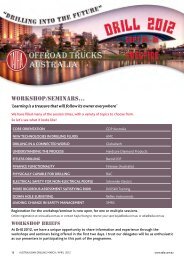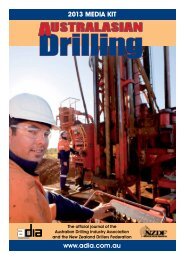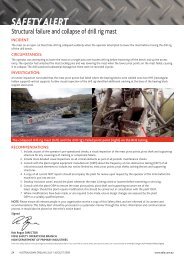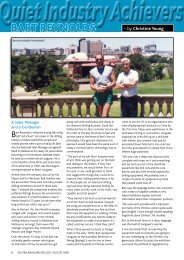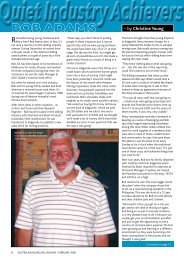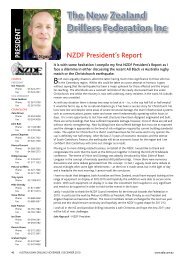Create successful ePaper yourself
Turn your PDF publications into a flip-book with our unique Google optimized e-Paper software.
uiet Industry Achievers<br />
DiNNY GRiMwOOD<br />
– by <strong>Christine</strong> <strong>Young</strong><br />
The Grimwood name is<br />
unmistakably etched in Western<br />
Australia’s modern drilling<br />
history. Dinny Grimwood has<br />
been part of the industry, on and<br />
off, for 57 years. In that time, he<br />
has headed up three companies<br />
and drilled for most resources all<br />
over the state and beyond.<br />
Dinny was born and bred in mining<br />
country and spent his formative years<br />
in Westonia, then Kalgoorlie. It was the<br />
right time and place for a young bloke<br />
who loved the freedom of working and<br />
travelling in the bush.<br />
“I’ve always liked travelling in the bush and<br />
drilling certainly keeps you on the move.<br />
You see a lot of country and you come<br />
across a lot of characters. It’s just one of<br />
those things you take to. I never got into<br />
the drilling industry to make a fortune. I<br />
just liked the industry, the people, being in<br />
the bush and the mobility, I guess”.<br />
Dinny left school at 14 and started out<br />
as a station hand at Mount Welds Station<br />
in Laverton. At the same time, he worked<br />
with drillers on the current Sunrise Dam<br />
mine site where he had his first experience<br />
looking for water. There were two other<br />
workers on this job with Dinny and the<br />
drilling method involved using a small<br />
jumper bar attached to a wire rope. The<br />
rope went through a pulley on a tripod and<br />
was threaded through a Mulga stick locked<br />
in place by a tapped punch.<br />
An old WABCO water boring rig in the 1950s<br />
“So there we were: two<br />
of us mugs would pull<br />
the Mulga stick down and<br />
release it for a 40 minute<br />
stretch. At the end of it,<br />
one came off and the<br />
other re-string went on for<br />
40 minutes. At 45 feet, we<br />
hit salt water so that was<br />
it. Thank God it was salt or<br />
we ‘d have had to sink a<br />
well on it”. It had already<br />
taken a week. If they’d hit<br />
fresh water, they would<br />
have got the contract to<br />
sink a bore which meant<br />
more intense labour.<br />
Four year later, Dinny was an offsider on a<br />
Wabco No.2 cable tool rig for a few months<br />
and had clearly caught the drilling bug.<br />
From there, he worked with diamond driller<br />
Lionel Honey who later became one of the<br />
first iron ore drillers in the Pilbara.<br />
“I was very fortunate actually because<br />
Lionel usually employed older people in<br />
their thirties and forties. But he was stuck at<br />
one point and I was lucky enough to get a<br />
start with him”.<br />
Dinny also learnt the ropes from a pair of<br />
water borers called Arnold and Alrick who<br />
would contract around the north eastern<br />
Goldfields for six months of the year and<br />
then return to Esperance for the other six<br />
months. “Their holes were as straight as a<br />
gun barrel and they were super efficient at<br />
their job. They were great guys and gave<br />
me a lot of clues on how it all worked. They<br />
were some of the real people in the industry<br />
at that time doing water bores”.<br />
RAB rig working in the Pilbara<br />
In 1966, Dinny purchased an old cable tool<br />
rig with his friend Leo Bonnie and they<br />
carried out numerous repairs to prepare<br />
it for work. Despite their best efforts, the<br />
trailer-mounted rig didn’t make it to their<br />
first job. The pin in the draw bar broke,<br />
causing the rig to roll over, shedding bits<br />
and pieces everywhere.<br />
“At this point, we heard Old Mac from<br />
Mount Welds Station coming. Leo<br />
suggested selling the rig to him. Old Mac<br />
pulled up: ‘You’ve got a bit of trouble<br />
boys?’ And Leo said ‘Yeah’. Mac, of course,<br />
said ‘What are you going to do?’ ‘We’ll sell<br />
you the rig mate’, Leo replied. Old Mac<br />
agreed. ‘Yeah, put it back together and train<br />
one of my blokes and I’ll buy it off you’. So<br />
we got out of that. We got our money back<br />
but nothing for labour”.<br />
This “massive comedy of errors” did not<br />
deter the budding driller. In 1968, after<br />
managing sheep stations with young wife<br />
Maureen, Dinny put the wheels in motion<br />
once more. “And then, believe it or not,<br />
we went from a sheep station to a service<br />
station in Coolgardie. Of course, that’s<br />
when the nickel boom really hit its straps<br />
and Kambalda was being developed. So I<br />
got the wanderlust again and that’s when<br />
it came time to give it another go on my<br />
own account”. Not without challenges. The<br />
small Landrover mounted rig he bought<br />
was not the most capable of machines.<br />
Through most of the 70s, Dinny<br />
drilled at Forrestania using a Mole<br />
Pioneer auger flight rig. Grimwood<br />
Drilling was well on its way but<br />
Dinny thought better results were<br />
possible with small rigs.<br />
10 AUSTRALASIAN DRILLING NOVEMBER / DECEMBER 2009 www.adia.com.au
RAB rig bogged at Forrestania during a wet winter in the 1970s<br />
“Geologists wanted to have a<br />
deeper look, wanted angle holes<br />
and all that, all the things that<br />
augers didn’t lend themselves to”.<br />
“It was time to put a compressor<br />
on the rig and convert to the<br />
system that the larger air rigs<br />
were using, thereby starting the<br />
RAB system which has been very<br />
successful. After having a win<br />
with the RAB in the early 80s, I<br />
purchased a few more rigs (all<br />
RAB) which worked well”.<br />
Dinny’s flair for innovation means<br />
he’s sometimes called a’pioneer’.<br />
But he says, “I don’t know about<br />
that. I just did what needed to<br />
be done. The Schramm seemed<br />
to be the popular rig of the day.<br />
They were drilling open hole of<br />
course with a bigger rig. All I did<br />
was basically scale that down to<br />
bring it down to a smaller fastermoving<br />
rig which of course didn’t<br />
drill to anything like the depth of<br />
those heavier ones. It was just a<br />
matter of thinking it through”.<br />
The key to building a rig suitable for one’s<br />
needs is for drillers to have a lot more<br />
input because, even though “there’s some<br />
very good engineers around to put a rig<br />
together, I think in a lot of cases, the<br />
drillers themselves don’t have enough<br />
input”, says Dinny.<br />
Grimwood Drilling was sold in 1987 and<br />
bought with Davies Drilling to become<br />
Grimwood Davies on the ASX. Dinny ran<br />
www.adia.com.au<br />
the company for a short while after the<br />
change of ownership then set up the<br />
appropriately named Challenge Drilling<br />
with son Peter and Jamie Seed. Peter has<br />
since moved on to form his own company,<br />
Direct Push Probing, in Perth. Dinny<br />
finished up on the rigs 20 years ago, and up<br />
until five or six years ago, was involved in<br />
the day-to-day running of Challenge where<br />
he still retains an interest. Many of the<br />
company’s current clients have been with<br />
them since the 1980s.<br />
Laverton, 1983<br />
Challenge Drilling’s current RC rigs are the<br />
brainchild of Dinny, Jamie and engineer<br />
Keith Littlely. “Jamie and I had a lot of<br />
input into those [rigs] to come up with<br />
what we wanted, and having Keith’s input<br />
as well, we’ve come up with a rig that fits<br />
in with the class we want. I don’t think<br />
there would be many better”.<br />
By the same token, Dinny chuckles at<br />
the thought of working on a modern<br />
rig. “Look, I’m frightened to touch the<br />
levers because it might turn into a snake<br />
and bite me”. On a serious note, bigger<br />
compressors and hands-free rod handling<br />
systems have had an enormous impact<br />
on rig performance and drilling results,<br />
he says. “The compressor I started with<br />
was 250cfm/100psi whereas now our<br />
RAB rigs have got 750cfm/400psi”. He<br />
also says constantly changing technology,<br />
better roads and transport have improved<br />
“out of sight. There are so many ways<br />
it’s improved, the past and present are<br />
practically chalk and cheese”.<br />
Dinny believes there are still many areas the<br />
industry could improve on. “For a start, I think<br />
safety is a big priority which probably comes<br />
back a little bit to the calibre of people a<br />
company employs. We need people who are<br />
willing to keep their noses clean and do their<br />
job right. The other one is training. If we get<br />
young folk into the industry who want to<br />
make a career out of it and hang in there,<br />
they will do quite nicely”.<br />
As an elder statesman in the drilling<br />
industry, Dinny has well and truly earned<br />
his leisure time and is now semi-retired.<br />
Recently, he has enjoyed travelling around<br />
Australia with Maureen and they are<br />
both active in supporting many causes<br />
including raising money for the Peel Health<br />
Foundation in Mandurah, the Leukaemia<br />
Foundation and donating to the Victorian<br />
bushfire appeal.<br />
Challenge Drilling staff, late 1990s.<br />
AUSTRALASIAN DRILLING NOVEMBER / DECEMBER 2009 11


